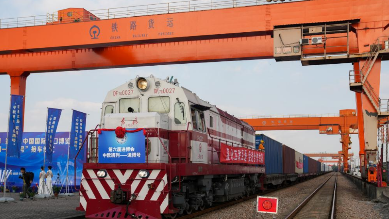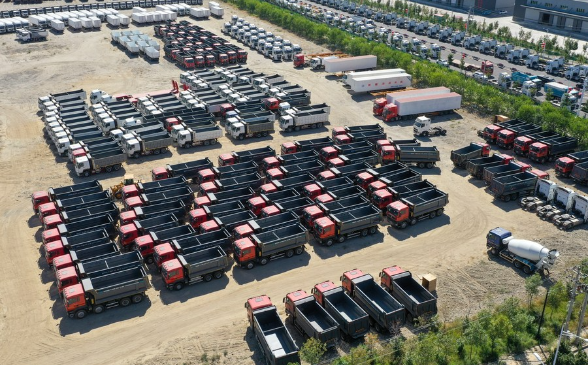
Amidst the evolving landscape of international commerce, China's groundbreaking infrastructure project has gained significant momentum. A key component of this initiative is the flourishing network of China-Europe freight trains, which are transforming the way goods travel between continents.
These high-speed trains, traversing thousands of kilometers through Eurasia, have become a vital lifeline for shipping a wide range of merchandise. From consumer goods, to raw materials, the China-Europe freight train network is facilitating efficient trade between Asia and Europe, fostering economic cooperation.
- Moreover, the trains offer several strengths over traditional sea freight. They are better protected from disruptions, sustainable compared to air transport, and provide a shorter transit time for time-sensitive goods.
- As a result a explosion in the number of China-Europe freight trains, with increased traffic observed annually. This trend is expected to perpetuate as businesses seek out more reliable ways to move their goods globally.
Bridging Capitals on Rails: The China-Europe Freight Train Network
A modern marvel of global logistics, the China-Europe freight train network seamlessly intertwines the economic powerhouses of Asia and Europe. This burgeoning rail corridor hauls a diverse range of goods, accelerating international trade and fortifying partnerships across continents.
With its extensive network of lines, the China-Europe freight train network promotes swift and efficient delivery of products. From technological hardware to crop produce, the network streamlines the flow of goods, injecting to global economic growth.
Moreover, the China-Europe freight train network offers a sustainable alternative to traditional shipping methods. By minimizing carbon emissions, the network plays a pivotal role in promoting environmentally responsible trade practices.
The future of the China-Europe freight train network looks optimistic. As global needs for faster and more streamlined transportation persist, this rail corridor is poised to evolve, connecting cities and fostering closer cooperation between nations.
Spanning Continents: The Rise of Rail in Logistics
Rail transportation plays as a essential element in the global logistics industry. With its robustness, rail unites continents, enabling the movement of goods across vast distances.

The recent surge in global trade has underscored the importance of efficient and reliable logistics solutions, and rail stands out as a key player in meeting these demands.
Upgrading rail infrastructure with state-of-the-art technologies is driving this revolution.
Smart systems, real-time tracking capabilities, and enhanced network connectivity are transforming the way goods are moved. This evolution in rail logistics provides a range of perks, including:
* Increased efficiency and speed.
* Minimized carbon footprint.
* Optimized safety and security.
The future of global logistics is inextricably linked to the advancement of rail transportation. As technology continues to develop, rail will undoubtedly remain a vital connector in integrating continents and driving global trade.
Strengthening Ties Through Transit: The China-Europe Railway Network
The tremendous growth of China-Europe freight train routes has stimulated a new era of economic and cultural collaboration. These modern railway lines span thousands of kilometers, effectively transporting goods from commercial centers in China to vibrant European markets across the continent.
- This trend not only streamlines global trade but also strengthens cultural exchange.
- ,Moreover, the China-Europe freight train routes have demonstrated to be a eco-friendly mode of transportation, reducing environmental impact compared to traditional shipping methods.
- Therefore, these railway lines are increasingly recognized as a vital link in the global economy and a driving force for fostering international collaboration.
A China-Europe Railway Connection
Iron Horse Diplomacy is a theory that emphasizes the ability of rail links in forging stronger political and economic ties. The China-Europe Railway Connection, a extensive network spanning thousands of miles, acts as China to Europe freight train a prime illustration of this diplomacy in action.

It promotes the movement of products between East and West, boosting trade and economic growth. But its influence extends beyond mere commerce, as it also strengthens cultural understanding and fosters cooperation between nations.
This system has become a emblem of globalization, underscoring the interconnectedness of the world today.
From Silk Roads to Steel Tracks: A Modern Legacy in Motion
These ancient pathways forged connections between civilizations, sparking commerce and the diffusion of knowledge. Today, we witness a new era of connectivity, as steel tracks snake landscapes, linking cities and nations in an intricate web. Just as the Silk Roads catalyzed innovation in the past, these modern rails spur progress, carrying people and commodities across vast distances. The legacy of connectivity endures, evolving with the times to reshape our world.
The influence of the Silk Roads is undeniable, a testament to human innovation. From exquisite materials to philosophical beliefs, these ancient routes facilitated the spread of cultural riches. This spirit of unity continues to thrive, as steel tracks become modern-day conduits for development.
Benchmarking Performance: China-Europe Rail versus Ocean Transport

The global trade landscape undergoes frequent transformations, and the competition between different transportation modes is fierce. Although ocean shipping has long controlled long-haul routes, China-Europe freight trains are emerging as a viable alternative, offering potential benefits in terms of speed, reliability, and environmental footprint.

A key consideration driving this shift is the increasing demand for faster delivery times. Rail connections between China and Europe can transport goods across continents in a fraction of the time it takes by sea, making them an attractive option for time-sensitive cargo. Furthermore, rail networks often offer more predictable delivery schedules, reducing the risk of delays and disruptions associated with ocean shipping.

Boosting Bilateral Relations Through Wheels and Rails
Strengthening diplomatic connections between nations often relies on fostering tangible collaborations. In this regard, the transportation sector presents a unique opportunity to enhance bilateral relations through wheels and rails. Investing in infrastructure projects such as railways and highways facilitates China to Europe freight train cross-border trade and commutation, bridging geographical distances and fostering economic interdependence. Moreover, joint ventures in the transportation sector can create employment opportunities, transfer technological expertise, and promote a spirit of cooperation between nations.
By breaking down physical barriers and linking communities through wheels and rails, we can pave the way for a more collaborative world order.
Tracking Global Trade: China-Europe Rail Transport's Impact growing
China-Europe rail transport has emerged as a crucial player in the global trade landscape. This mode of transportation offers a efficient alternative to traditional shipping routes, reducing transit times and costs. The influence of rail transport on China-Europe trade is substantial, contributing to the growth of bilateral economic relations.
- The increased rate of rail freight between China and Europe has stimulated the exchange of goods, ranging from consumer products to industrial components.
- Moreover, rail transport has supported the expansion of regional markets along the trade corridors.
- However, challenges such as infrastructure limitations and regulatory discrepancies need to be addressed to fully harness the potential of rail transport in China-Europe trade.
Tracking the patterns in China-Europe rail transport provides valuable insights into the evolving dynamics of global trade.
The Green Alternative: Sustainable Freight on the China-Europe Express
As global trade expands, finding sustainable solutions for freight transport becomes increasingly crucial. The China-Europe Express, a network of rail lines connecting Asia and Europe, presents a compelling alternative. By shifting cargo from road to rail, this innovative system significantly reduces carbon emissions, contributing to a greener future for international commerce. The advantages are manifold: reduced reliance on fossil fuels, minimized congestion on European roads, and a faster transit time compared to traditional maritime routes. Additionally, the China-Europe Express facilitates economic growth by connecting manufacturers with global markets, fostering trade and development along the route.
- The express network offers a versatile platform for transporting a wide range of goods, from industrial products to consumer merchandise.
- Such a shift towards sustainable freight practices aligns with the global push for decarbonization and environmental protection.
- The success of the China-Europe Express demonstrates that innovation in logistics can create both economic and environmental gains.
A Pulse of Progress: The China-EU Rail Link's Economic Growth
The China-Europe freight train has emerged as a vital/crucial/significant artery in the global economy, facilitating/connecting/streamlining trade between Asia and Europe. Spanning/Running across/Stretching along thousands of kilometers, this modern marvel transports a diverse/wide range of goods, from manufactured products to agricultural commodities. The tremendous/exponential/rapid growth in freight volume has had a profound/noticeable/significant impact on both regions, boosting economic development/expansion/prosperity and creating new opportunities for businesses.
Moreover/Furthermore/In addition, the train route fosters cultural exchange/interaction/communication between participating countries, strengthening/building/enhancing ties and promoting mutual understanding.

The success of the China-Europe freight train is a testament to the power of international cooperation/collaboration/partnership. Looking ahead/On the horizon/Moving forward, this dynamic/thriving/booming trade corridor is poised for even greater expansion/growth/development, further fueling/driving/propelling economic progress and global integration.